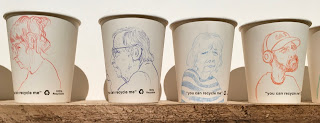Liliane Lijn ‘Arise Alive’ Tate St Ives, 2025 May 23rd to November 2nd.
Liliane Lijn’s work fills the new gallery at Tate St.Ives, making a dramatic expression of her long life as an artist and she was there at the private view.
How great indeed to see a woman artist celebrated whilst still alive.
In the 60’s she began using technology to make kinetic work using acrylic and light and her ‘Liquid Reflections’ which is viewed in a dark room is fascinating to watch as pairs of spheres move about on circular platforms, occasionally bumping into each other or the rim with a soft sound and casting ever changing shadows and reflections.
This was made in 1968 and as a student I saw it in Nottingham. I even made my own circular platform with moving spheres afterwards. Mine was plywood, mounted on bed springs so that it hovered if touched, and my many spheres were polystyrene coloured pink blue or a mixture of both. Mine was symbolic of people bumping into each other, a product of the excitement of being at college studying art and suddenly meeting lots of people. This makes me wonder if Lijn’s symbolises the meeting of two people.
Some ideas are in the air of an era. I find Yoko Ono exhibited one clear sphere on a plinth in 1964, with a conceptual label - ‘Pointedness 1964, first realised 1966. Crystal sphere, acrylic pedestal. Engraved: POINTEDNESS YOKO ONO 1964 / THIS SPHERE WILL BE A SHARP POINT WHEN IT GETS TO THE FAR CORNERS OF THE ROOM IN YOUR MIND”
Ono characteristically says a lot with a ‘less is more’ wit, contrasting with Lijn’s use of motors and technology.
Lijn also used prisms and I remember in 1971 being sent out to Tottenham Court Rd whilst studying to be an art teacher at London University ‘s institute of education to buy some, as many others must have done.
Of course Tate as usual present an artist in a solo show with no context which is why I note that ideas are often widespread - but Lijn was able to seize the moment and made remarkable work with them.
Lijn comes from a wealthy family, met important people in the art world - surrealists in Paris, and she married Takis a wealthy successful Greek artist so she was able to devote herself to art, even sending her son away to be looked after by her separated parents in turn.
Her love life was rather turbulent until she met her current husband.
Alongside the cool quiet work there are paintings and sculptures that are linked to psychology, to archetypal figures of woman.
Here Lijn uses colour and expressive marks to convey strong feelings. Her ‘ Good Mother, Bad Mother’ reminded me of Kokoschka in their swirling application of colour.
The two large sculptures, ‘Woman of War and Lady of the Wild Things’ that perform together on the hour using light, sound - sung by Lijn - and spouts of steam - carry on the theme of woman as having strength, sometimes frightening, sometimes wild but welcoming.
The show is on until November and there is a lavishly illustrated book to accompany it plus Lijn’s memoir ‘Liquid Reflections’ which is an easily flowing candid account of her life.
Unfortunately Tate have discontinued the helpful booklets that used to inform and be a memento of shows, but as photos are allowed you can make your own selection of images and wall captions and also you may attend the talks that are given where your questions can be answered.
Lijn’s show is wonderfully varied and is likely to remain in the memory of visitors as a unique event as well as confirming her place in the canon of art history,


















